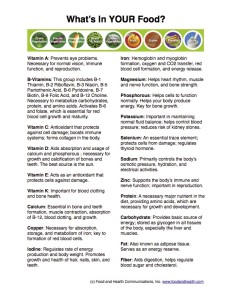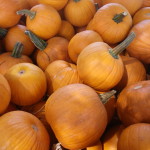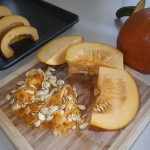You know what has been flying off the shelves lately?
The Vitamin and Mineral Chart. This poster highlights particular foods that are rich in certain vitamins and minerals. Since most consumers need to eat a more plant-based diet in order to avoid excess saturated fat, sodium, and added sugars while somehow managing to get enough nutrients in the calories allotted, it’s wise to have a few materials that could make that transition easier. This chart has been an eye-catching tool for inspiring and maintaining motivation, along with teaching key nutrient lessons.
As a special bonus, I want to share the printable educational handout that comes with the poster. Normally you could only access this if you had already bought the poster, but today I’m going to make an exception. The Eat Your Nutrients handout features macronutrients and micronutrients alike, highlighting the health benefits of these vital food elements.
Enjoy!
Vitamin A: Prevents eye problems. Necessary for normal vision, immune function, and reproduction.
B-Vitamins: This group includes B-1 Thiamin, B-2 Riboflavin, B-3 Niacin, B-5 Pantothenic Acid, B-6 Pyridoxine, B-7 Biotin, B-9 Folic Acid, and B-12 Choline. Necessary to metabolize carbohydrates, protein, and amino acids. Activates B-6 and folate, which is essential for red blood cell growth and maturity.
Vitamin C: Antioxidant that protects against cell damage; boosts immune systems; forms collagen in the body.
Vitamin D: Aids absorption and usage of calcium and phosphorous ; necessary for growth and calcification of bones and teeth. The best source is the sun.
Vitamin E: Acts as an antioxidant that protects cells against damage.
Vitamin K: Important for blood clotting and bone health.
Calcium: Essential in bone and teeth formation, muscle contraction, absorption of B-12, blood clotting, and growth.
Copper: Necessary for absorption, storage, and metabolism of iron; key to formation of red blood cells.
Iodine: Regulates rate of energy production and body weight. Promotes growth and health of hair, nails, skin, and teeth.
Iron: Hemoglobin and myoglobin formation, oxygen and CO2 transfer, red blood cell formation, and energy release.
Magnesium: Helps heart rhythm, muscle and nerve function, and bone strength.
Phosphorous: Helps cells to function normally. Helps your body produce energy. Key for bone growth.
Potassium: Important in maintaining normal fluid balance; helps control blood pressure; reduces risk of kidney stones.
Selenium: An essential trace element; protects cells from damage; regulates thyroid hormone.
Sodium: Primarily controls the body’s osmotic pressure, hydration, and electrical activities.
Zinc: Supports the body’s immune and nerve function; important in reproduction.
Protein: A necessary major nutrient in the diet, providing amino acids, which are necessary for growth and development.
Carbohydrate: Provides basic source of energy; stored as glycogen in all tissues of the body, especially the liver and muscles.
Fat: Also known as adipose tissue. Serves as an energy reserve.
Fiber: Aids digestion, helps regulate blood sugar and cholesterol.
And here’s a free printable copy of the handout!
Looking for more nutrition education materials? Here are some of the newest resources to hit the store!











